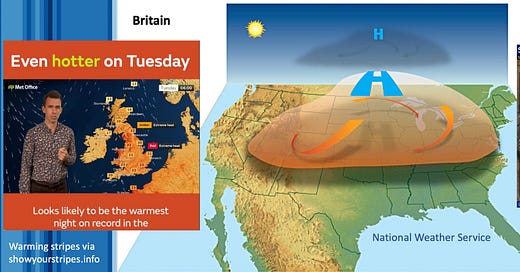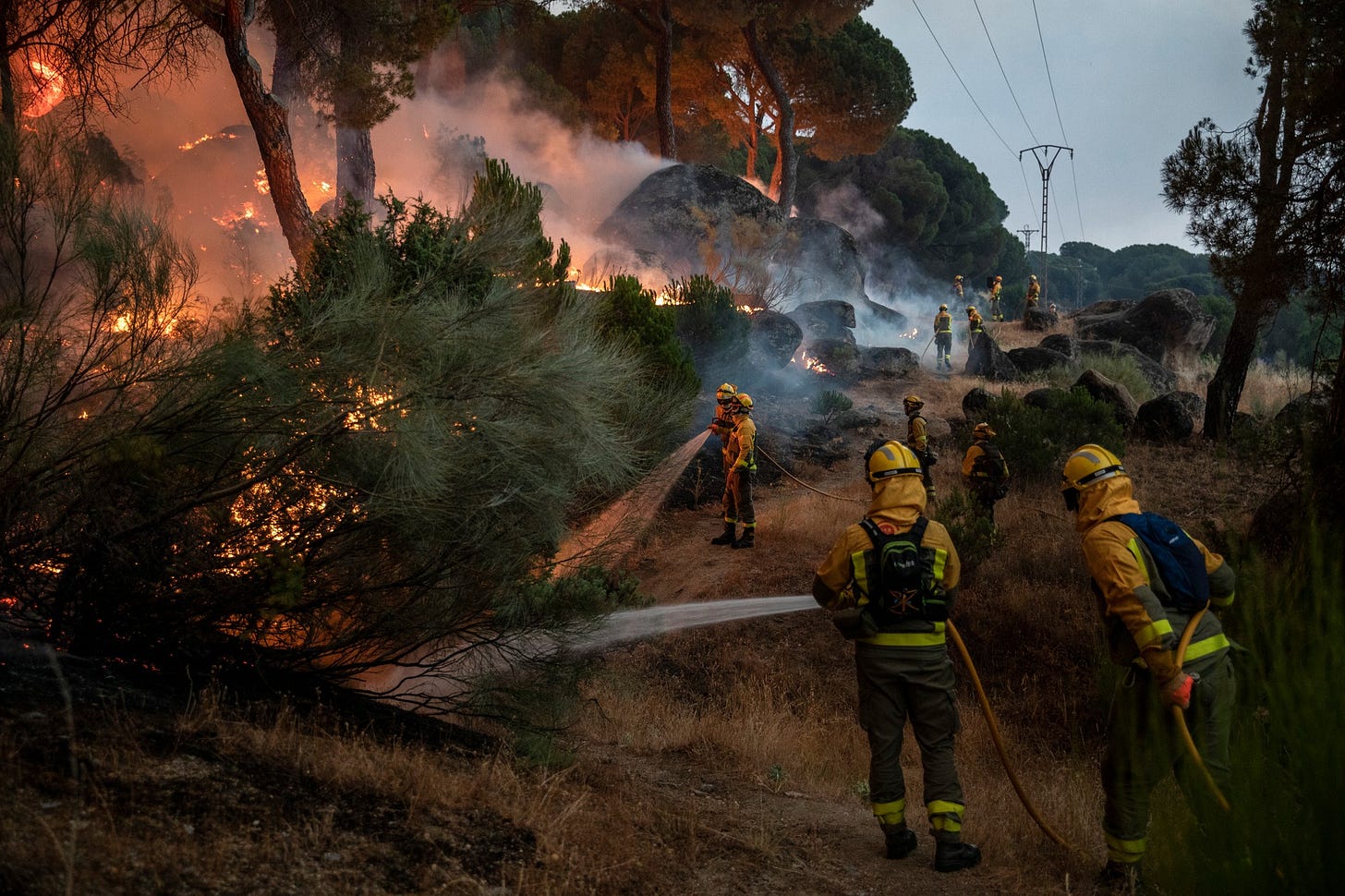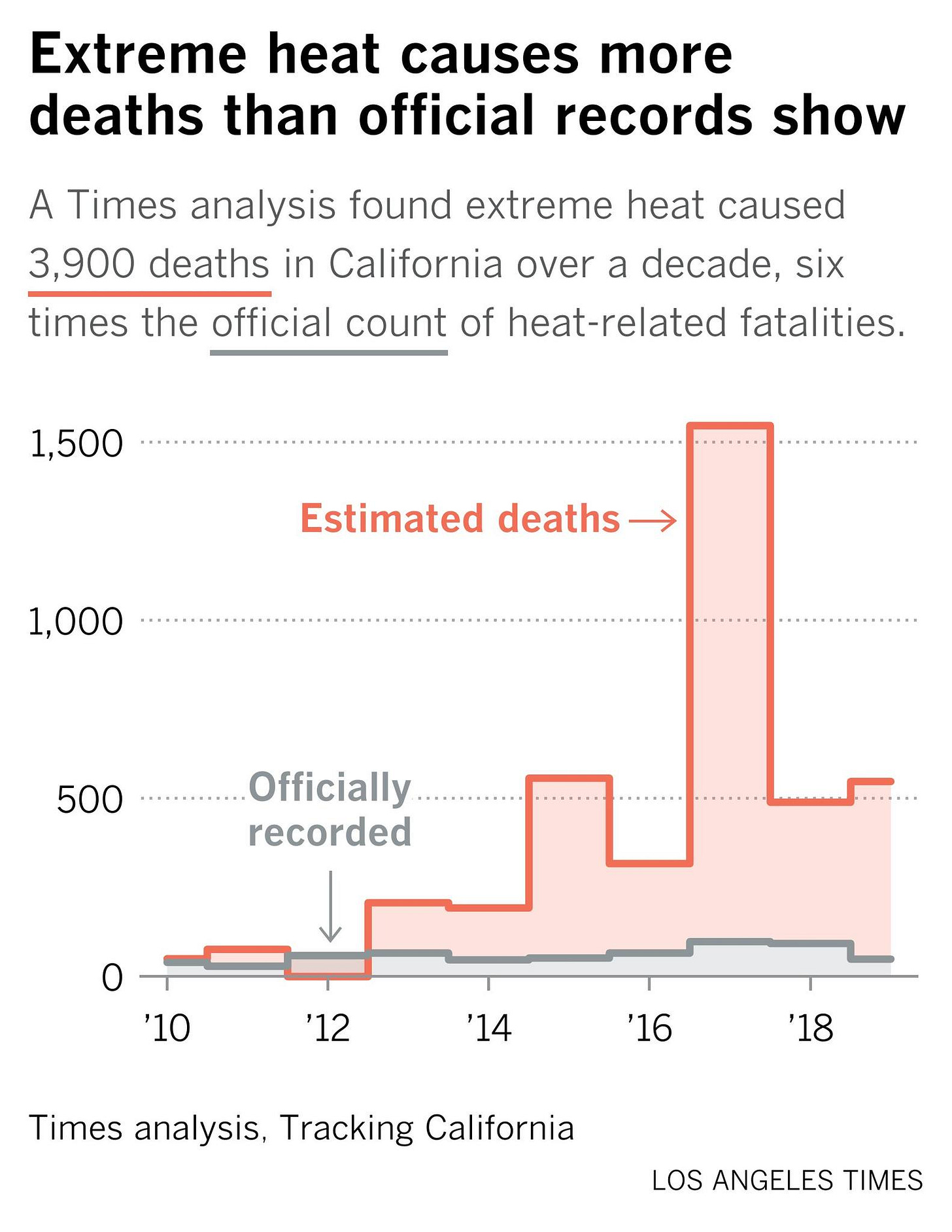As Global Warming Fuels More Heat Emergencies, Cut Vulnerability Now and CO₂ Always
Don't let the heat, or the size of the climate problem, paralyze you. There are cool solution paths cutting climate risk down the block or around the world.
Track my companion live video webcasts, including a live pop-up show on beating the heat.
Here’s my discussion of a vital 2022 report from humanitarian assistance organizations offering strategies for getting ahead of extreme heat - shifting from emergency response to a proactive, preventive data-driven approach:
The report, commissioned jointly by the United Nations and International Red Cross, released late in 2022, is Extreme Heat: Preparing for the heatwaves of the future. My guests were the report’s lead author, Greg Puley, chief of the Middle East and North Africa section in the United Nations Office for the Coordination of Humanitarian Affairs, and Achala Navaratne, an IFRC and leading expert on managing climate disasters in Bangladesh and South Asia.
Original post, July 18, 2022 (but can be almost any summer)
What a summer it has been in the Northern Hemisphere, with more unprecedented heat waves, fires (and storms) ahead.
Even as the central and southern plains and Southwest in the United States once again face a sustained extreme heat dome, triple-digit temperatures following earlier heat waves have, as predicted, triggered dozens of fires in Southwestern Europe. A thousand deaths from heat have been reported so far in Spain and Portugal, and true numbers always lag.
Firefighters try to protect houses on Monday in Avila, Spain (Photo by Pablo Blazquez Dominguez/Getty Images)
Britons are bracing today for the highest temperatures in centuries of record keeping. On Monday, the Columbia University climate scientist Simon Lee tweeted this observation about Britain's Met Office, the country's weather and climate agency: "In 2020, the @metoffice produced a hypothetical weather forecast for 23 July 2050 based on UK climate projections. Today, the forecast for Tuesday is shockingly almost identical for large parts of the country."
The off-the-scales heat across Europe has already triggered a host of dramatic incidents, including ice avalanches in Italy and Kyrgyzstan.
There've been so many toppled heat records, so many headlines and red alerts - not to mention climate-policy defeats - that there's a risk of more of the paralytic "psychic numbing" I wrote about recently in the context of both climate change and pandemic losses - and just when engagement and acton are most needed.
So where do you start?
Some environmentalists are using this moment to press politicians, particularly President Joe Biden, to invoke emergency powers to cut to the root and stop fossil fuel production. Here's Jean Su of the Center for Biological Diversity:
Of course, as the related Wall Street Journal story quoting Su explained, "Some of those measures could raise gasoline prices and other energy costs for consumers, something Mr. Biden wants to avoid as his Democratic Party faces crucial midterm elections."
Welcome back to what I've been calling Biden's Bind.
Whose climate emergency
I'm sure the Declare Emergency campaigners who shut down Interstate 495 on the Fourth of July are planning more actions. One problem with this tactic is the world is in multi-dimensional emergency overload, with others pressing the case for an energy emergency and of course a democracy emergency, and there's that simmering pandemic and.....
I recommend a different path.
Focus on identifying hot spots of climate vulnerability (down the block or around the world), or energy opportunity (billions of dollars in clean-energy loans waiting for 19,500 American communities), and use your particular skills and networks, at whatever scale suits you best, to make incremental, but measurable progress.
Individual action has been much derided of late - by those correctly noting that industries dead-set on maintaining the fossil fuel status quo have tried for decades to sell us the narrative that global warming is our fault.
Individual action has been attacked by others, correctly, because we all know that what is needed is system change, not light bulb change. (These arguments were hashed out in my event with Orion Magazine last week.)
But what is the path to system change? A transformative movement starts through a thousand dispersed individual experiments, campaigns and tests on the ground - some in court (ourchildrendstrust.org), some technological (myheat.ca), some social (yes, including protests like Fridays for Future), some educational (like a boiler room tour!), some legislative (the Green New Deal lives on as a framework for equitable and systemic climate action).
And I do think communication experiments can play a role.
The first 20 years of my global warming reporting, from 1988 through 2007 were mostly explanatory science and policy journalism - me, the reporter, telling stories to you, the audience, using a widening array of tools.
Even as hundreds of journalists have migrated to the climate beat, so far there's little sign that media coverage will tip some balance, and not just because fossil fuelers have pumped hundreds of millions of dollars into building political control and maintaining the status quo through sustained p.r. campaigns.
Media, particularly in the "Instanet" age, are not well set up to address wicked problems. But piece by piece, applying skills and partnerships in new ways, they are making a difference.
A Los Angeles Times series last October, in part driven by a novel partnership with epidemiologists, revealed that many times more deaths in California were the result of extreme heat than official counts. Los Angeles in June launched an extreme heat mobilization campaign in part as a result. I hosted one of the journalists, Tony Barboza, in an inspiring Sustain What webcast, Journalists and Scientists Dig in on Vulnerability to Extreme Heat, that you can watch below.
There are exciting explanatory innovations all the time, including the warming stripes in the background of the banner image above, which I explored with their creators and communication scientists in a Sustain What webcast. Here's another from Climate Central explaining one of the most basic and established realities of greenhouse-driven global warming - that a small change in the average temperature drives a big change in extremes. (Explore more data and resources at their website for heat in 2022.)
As the British meteorologist Scott Duncan tweeted on Sunday, "A warmer world, thanks to human induced climate change, makes it almost effortless to break extreme heat thresholds. We continue to see this across the planet - not just in Europe."
Not fun in the sun
This is a good time to break "same old" patterns. If you’re in the media, try to avoid quick-reflex imagery – folks cooling off in a pool - when covering heat emergencies. Saffron O’Neill of the University of Exeter has been leading research on visual information and climate and has repeatedly warned against this practice given the outsize impact of heat on poor or marginalized populations, including farm workers at the scorching end of the supply chain to your refrigerator. Read her Guardian column: "‘Fun in the sun’ photos are a dangerous distraction from the reality of climate breakdown." But she noted on Twitter that even The Guardian drops the ball.
Here’s a core point from a commentary O’Neill wrote for the Academy of Social Sciences:
This is not a call to end every image of people having a good time in hot weather. Living in often rainy Devon, I welcome a sunny, dry day as much as anyone. However, there is a need for us to critically examine the visuals which are used throughout the media – and indeed the images we might call to mind ourselves when visualising extreme heat – to make sure that vulnerable people are not excluded, and that options for adapting to hotter weather are not out of sight.

Overall, I see the greatest potential for communication impact in moving from telling a better story, my stock in trade for decades, to fostering more productive conversations and connectedness. This can occur within communities to foster resilience and between communities and sources of information and expertise that can boost access to clean energy or cut vulnerability to hazards.
Examples that excite me include the Rural Climate Dialogues and Rural Energy Dialogues pioneered some years back by the Center for New Democratic Processes (under a different name). According to the journalist Madeline Ostrander, that model lives on, and I can't wait to run a Sustain What conversation with her when her book on home-grown climate responses, is published.
INSERT - here’s that conversation, also with author Elizabeth Rush!
I mentioned myheat.ca, which, on the energy side, has been mapping solar panel installations and the insulation level in homes in Canadian cities, and the cool-block / hot-block infrared heat imagery and cool urban planning tool developed for Portland, Oregon, by Vivek Shandas of Portland State. I had a Sustain What chat with them as well, along with a neat team at Boston University using data to tell energy stories.
Get ahead of the heat
These efforts just scratch the surface of what's possible by getting ahead of the heat.
I've been heartened to see a burst of attention being paid to the work of Eric Klinenberg, the New York University sociologist whose book on the 1995 Chicago Heat wave so clearly revealed the power of social cohesion in cutting risk and loss. Please explore the links in his Twitter thread here for starters.
He starts off with a provocation:
"I'm getting a lot of calls from European journalists and officials who want to know how to survive the searing heat. Here's the answer: Stop burning fossil fuels."
But Klinenberg also lays out links to his decades of work showing what can be done on the ground to cut risk in communities in peril even as work is intensified to curb emissions driving warming.
"Nobody needs to die in a heat wave"
No one is better at articulating what needs to be done to avoid human losses from extreme heat events than Kristie Ebi, a professor of environmental and global health at the University of Washington and lead author on the landmark 2018 Intergovernmental Panel on Climate Change report on 1.5 degrees of warming.
Ebi doesn't mince words, saying repeatedly, and convincingly, that "nobody needs to die in a heat wave."
In a new commentary published by Project Syndicate, she notes research finding global warming is responsible for almost 40 percent of heat-related deaths worldwide and lays out how money can be invested now to lower losses. "Effective early-warning systems already exist worldwide, including in low-resource settings such as Ahmedabad, India," she writes, noting that organizations like the Global Heat Health Information Network are collecting and sharing data on local and national experiences and best practices.
But that only works if communities large and small are reaching out to link in to such networks.
Ebi has been on several of my Sustain What webcasts, including one you can watch below. I conducted a longer video interview with her after the great Pacific Northwest heat emergency of June 2021. Every word is a relevant now as then. I'll be streaming it live at noon U.S. Eastern time today and going over the day's heat headlines.
Watch and join me here:
Cool data point
As you reflect on how few British homes have air conditioning (Daniel Victor of The New York Times cites a British government study estimating 5 percent) consider data from the 2020 U.S. Census and Energy Department showing about 90 percent of American households do. The household renovation website Fixr ran the numbers and got a figure closer to 95 percent. Here's their region-by-region timeline graphic.
Where does the energy come from to run all that AC - not to mention the unmet air conditioning demand across the rest of the planet (which I wrote about long ago)?
That's for another post.
Read and watch
Surviving a Future of Extreme Heat - Project Syndicate essay, by Kristie L. Ebi, June 5, 2022
Unprecedented extreme-heat episodes like the heatwave in India and Pakistan this spring and the 2021 heat dome in the Pacific Northwest are a preview of what awaits us on a warming planet. Unless we improve our early-warning and response systems, the number of excess deaths each year will increase.
Columbia Climate School News Review - Handing the Heat (July 15)
Journalists and Scientists Dig in on Vulnerability to Extreme Heat (October 8, 2021)
Live from the West’s Historic Heat Dome, Designing Paths to Urban Safety (June 28, 2021)
Thanks for commenting below or on Facebook.
Subscribe here free of charge if you haven't already.
Send me feedback (including corrections!), tips, ideas here.
Find my social media accounts, books and music in a click here. And please share Sustain What with solution-focused friends and colleagues.
Postscripts
My Bulletin colleague Ian Bremmer is great at dark humor, as in this post: "Sure, it's the hottest summer Europe has ever had in history. But look at the upside. It's one of the coolest summers Europe will ever have going forward."
Thinking again of the clarity of the relationship between general warming and the frequency and strength of extreme heat, I'm still haunted by this line in my 1988 Discover Magazine story on global warming, citing one of the earliest pioneers in climate research:
"Average climate will certainly get warmer," says Roger Revelle, an oceanographer and climatologist at the University of California at San Diego. "But what's more serious is how many more hurricanes we'll have, how many more droughts we'll have, how many days above one hundred degrees.''
The impact of global heating on drought and hurricanes has proved to be more complicated than what was understood then, but Revelle nailed the temperature issue.









